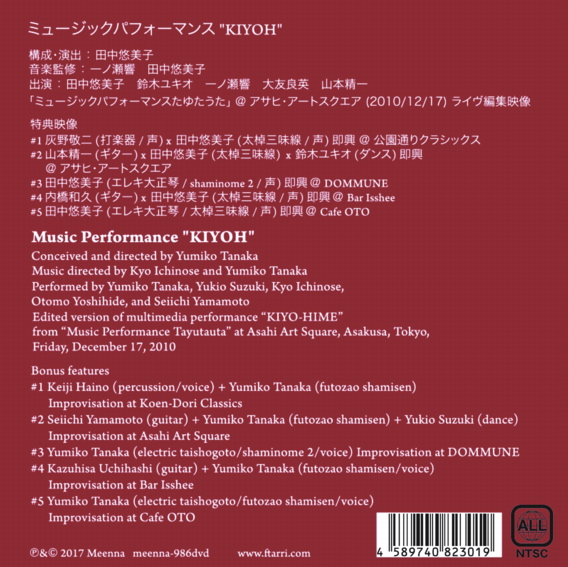

DVD
meenna-986dvd
Out on Jun 25, 2017
Purchase price in Japan: 2,000 yen (tax not included)
(For purchase outside of Japan, prices vary.)
Music Performance "KIYOH" (48:07)
Conceived and directed by Yumiko Tanaka
Music directed by Kyo Ichinose and Yumiko Tanaka
Performed by Yumiko Tanaka, Yukio Suzuki, Kyo Ichinose, Otomo Yoshihide, and Seiichi Yamamoto
Edited version of multimedia performance "KIYO-HIME" from "Music Performance Tayutauta" at Asahi Art Sqaure, Asakusa, Tokyo, Friday, December 17, 2010
Bonus Features
Yumiko Tanaka is a gidayu shamisen player active in the fields of contemporary classical and improvised music as well as traditional Japanese music. Tanaka performed as a musician and actress in Hashirigaki (premiered in 2000), a music theater production by German composer/director Heiner Goebbels; and created the music for and performed in Dogugaeshi (premiered in 2004), an object theater work by American puppeteer Basil Twist. Based on these experiences, in December 2010 she created, produced and performed in the multidisciplinary theater production "Music Performance Tayutauta." This DVD contains "Music Performance 'KIYOH,'" the edited video of that 2010 production of "Music Performance Tayutauta."
This work "is an endeavor to detach from the traditional performing arts context gidayu bushi [narrative recitation accompanied by shamisen] and gidayu shamisen, which began in the Edo period as music for ningyo joruri [traditional puppet theater] and also developed as kabuki music and narration, and to recreate the worlds of these stories as contemporary multimedia performance through collaboration with creators from fields including electronics, dance, puppet theatre, video and lighting." It is an extremely ambitious work born of Tanaka's wide-ranging activities and experience, and her outstanding performance and production skills. In addition to Tanaka, Yukio Suzuki (dance), Otomo Yoshihide (electric guitar) and Seiichi Yamamoto (electric guitar) appear in some segments. Kyo Ichinose served as music director and created the electronic sound.
In addition to the the central work, "Music Performance 'KIYOH,'" this DVD includes five bonus videos: two solo performances by Yumiko Tanaka (electric taisho-goto, shaminome 2, voice / electric taisho-goto, shamisen, voice); a duo by Keiji Haino (percussion, voice) and Tanaka (shamisen, voice); a duo by Kazuhisa Uchihashi (guitar) and Tanaka (shamisen, voice); and a trio by Seiichi Yamamoto (guitar), Tanaka (shamisen) and Yukio Suzuki (dance).
The release of this DVD comes at the end of the long start-and-stop process of editing the video documenting "Music Performance Tayutauta," which I produced at Asahi Art Square in 2010. The many re-edits included retakes of the insert video and the retrieval of footage that had been taken with a home video camera. I gave a tremendous amount of work to Takashi Kurokawa, who patiently went along with the various extravagant requests I made on our work days. I entrusted the sound to Kyo Ichinose, who played important roles as music director and musician. He added new recordings to the ones made at the venue and carefully mixed the sound. It is not an overstatement to say that the original performance was reborn in a more ideal form
thanks to their efforts.
As for what's called the "interpretation of the work," I'm leaving that entirely to those who watch this DVD. Having said that, here for your reference are excerpts of program-notes-style texts from the performance leaflet and press release written at that time.
This is an endeavor to detach from the traditional performing arts context gidayu bushi [narrative recitation accompanied by shamisen] and gidayu shamisen, which began in the Edo period as music for ningyo joruri [traditional puppet theater] and also developed as kabuki music and narration, and to recreate them as contemporary multimedia performance through collaboration with creators from fields including electronics, dance, puppet theater, video and lighting. Tanaka references the expressive forms of the Noh play "Dojoji"1 and the bunraku play "The Cherry Trees along the Hidaka River,"2 and centripetally embodies and integrates them by disassembling, reinterpreting and restructuring, moving, playing the shamisen and reciting, and manipulating puppets.
"Anchin Kiyohime" and "Dojoji," stories handed down by Japanese for over a thousand years, have a certain outrageousness. Was Kiyohime merely a stalker? Who was she and where did she come from? What did she try to tell us?
What led me, a shamisen player, to create this type of multidisciplinary work was the experience of creating the music for and performing in Dogugaeshi (premiered at the Japan Society in 2004), an object theater work by New York puppeteer Basil Twist (recipient of the 2015 MacArthur Genius Grant). Later, as a recipient of the 2006 Asian Cultural Council grant, I spent five months researching various types of performing arts in New York City; and in 2008, as a grantee of the Japanese Government Overseas Study Program for Artists, I studied puppet theater production with Basil. The results of these experiences are given form in Kiyoh.
The genesis of Dogugaeshi's realization was my experience performing as a musician and actress in Hashirigaki, a music theater production by the renowned German composer/director Heiner Goebbels (premiered in 2000 at the Théâtre Vidy-Lausanne). It was at the New York performance of Hashirigaki that I first met the Japan Society's artistic director, Yoko Shioya, who brought me and Basil together. The dreamlike experience of participating in the creation of Hashirigaki over the course of a month in Lausanne is a unique treasure in my life. Heiner's methodology of musical theater creation and his approach to theater productions, in which the interpretation of the work is entrusted to viewers, are reflected, however modestly, in my work.
This work was created as a question to myself. I don't have the answer yet. What I can say is that, while I've always swayed, wandered and drifted between the dichotomous key words "art/performance," "past/future," "man/woman," "dominating/dominated," "analog/digital," "conscious/unconscious," "time/space," I have the feeling that in this work, and in my life, I'm heading towards a sort of integration and synchronizing with the upheaval that has occurred in the world since March 11, 2011.
Lastly, in addition to the main work, this DVD includes five bonus videos from live performances of improvised music—which in the vast expanse of all my performance activities is the one that has continued the longest. "shaminome 2" is the second version of "shaminome," which was produced by Shunichi Yamamoto of tkrworks. In each performance, whether I'm playing shamisen or taishogoto or shaminome, the feeling is simply "Oh, she got the instruments to play with her—it looks like she's having fun!" That may be the true worth of Yumiko Tanaka. (Yumiko Tanaka)
1. Summary of the Noh play "Dojoji"
A service is held to dedicate a bell restored to Dojoji temple. That day, a female dancer appears from nowhere and dances a dedication dance; then she causes the bell to fall to the ground and hides beneath it. The monks perform an exorcism and raise the bell. The woman appears, transformed into a serpent which then burns itself with the flames of delusional obsession and disappears at the bottom of the Hidaka River.
2. Summary of "Anchin Kiyohime," a tale from Dojoji temple in Wakayama Prefecture
Kiyohime, the daughter of Masago Shoji, falls in love at first sight with a young monk from Oshu named Anchin, who stops for a visit during a pilgrimage to the Kumano shrines. When Anchin leaves, Kiyohime follows him, jumping into the Hidaka River. In her obsessive pursuit, she transforms herself into a serpent and swims across the river. Anchin has been sheltered in the bell of Dojoji temple. Kiyohime burns him to death with flames of anger. The bunraku play "The Cherry Trees along the Hidaka River" is a dramatization of this story.
